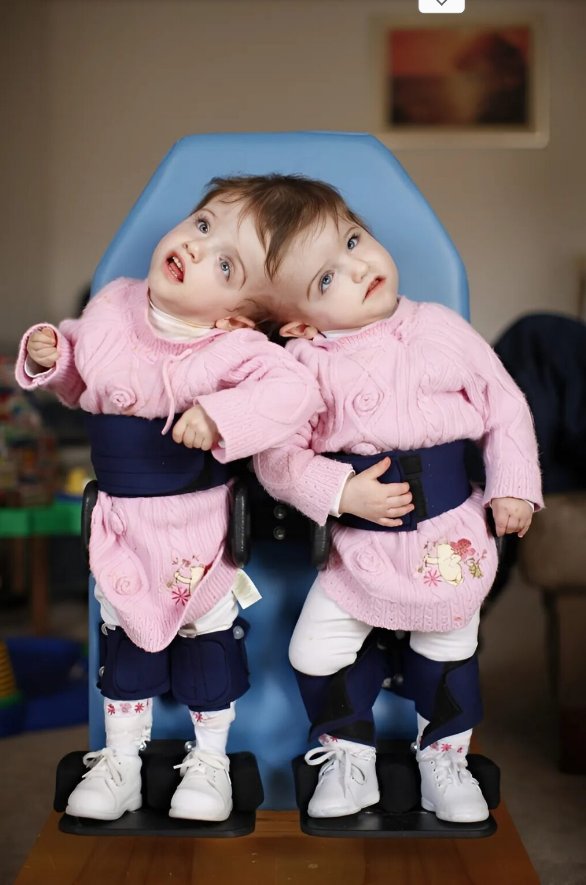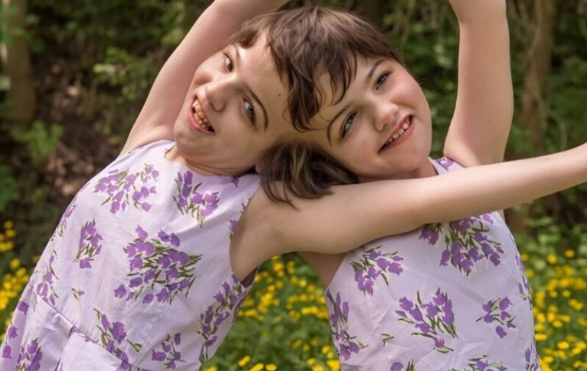
In 2006, in the quiet heart of British Columbia, Canada, the Hogan family witnessed a miracle that would capture worldwide attention. Twin girls, Tatiana and Krista, entered the world in a way few could ever imagine — conjoined at the head. Their arrival left doctors speechless and the scientific community in awe. From the very first moment, it was clear: this wasn’t just a rare medical occurrence, it was an almost unheard-of phenomenon.
Tatiana and Krista were diagnosed with craniopagus, one of the rarest conditions on earth — twins joined at the skull. It happens in only about 1 in 2.5 million births, and tragically, most don’t survive more than a single day. Doctors feared the same fate for the Hogan sisters, convinced they wouldn’t make it past 24 hours. But these girls proved everyone wrong. Not only did they survive… they flourished.
What makes Tatiana and Krista’s story truly extraordinary isn’t just their physical connection — it’s their neurological bond. While each sister has her own brain, they’re linked by a rare structure known as a thalamic bridge. This remarkable connection between their thalamus regions creates a neural pathway so powerful that it allows them to share senses and even emotions. It’s as though their minds are constantly tuned to each other — not a single person, but two unique individuals living in perfect sync.

Because of their rare connection, Tatiana and Krista experience life in ways the rest of us can barely imagine. If one feels pain, the other flinches. When Krista bites into an orange, Tatiana can taste the tangy citrus on her tongue. If Tatiana feels a surge of fear or excitement, Krista instantly senses it — no words needed. To researchers, it’s the closest thing to real-life telepathy the world has ever known.
Yet despite this extraordinary bond, they are not one person — they are two. Tatiana is calm, thoughtful, and observant, preferring quiet moments and careful reflection. Krista is her opposite: bold, expressive, and full of energy, with laughter that fills a room. Their differences don’t divide them; instead, they make their connection even more fascinating — and profoundly beautiful.
From the very beginning, their family refused to let medical limitations define them. The Hogans focused on giving the girls a life filled with joy and possibility. They encouraged swimming lessons with a private instructor, had a special bicycle built so the twins could ride together, and celebrated every milestone. Against all odds, Tatiana and Krista even learned to run — something doctors once thought impossible — moving in perfect rhythm, balancing one another with every step.

Life hasn’t always been easy for Tatiana and Krista. When they reached preschool age, not every parent was comfortable with their children interacting with “different” classmates. There were whispers, curious stares, and awkward questions. But the Hogans never wavered. The girls joined a regular school, and over time, they carved out their place in the world.
Because of their unique brain connection, Tatiana and Krista experienced some cognitive delays. Yet with patient teachers, unwavering family support, and their own remarkable determination, they learned to read, write, and tackle math problems — proving that with love and persistence, even the most extraordinary challenges can be overcome.

Now, at 19, Tatiana and Krista continue to amaze everyone around them. Vibrant, curious, and full of life, they share laughter over inside jokes only they could understand and often complete each other’s thoughts — sometimes literally. Their story is a marvel of rare biology, yes, but it’s also a testament to unbreakable love, family devotion, and the limitless strength of the human spirit. Their bond goes far beyond the physical; it’s a profound connection that reminds us all of what true intimacy, understanding, and unity can look like.


